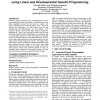544 search results - page 47 / 109 » Testing concurrent programs using value schedules |
109
click to vote
GECCO
2010
Springer
15 years 2 months ago
2010
Springer
Evolutionary methods have been used to repair programs automatically, with promising results. However, the fitness function used to achieve these results was based on a few simpl...
SIGSOFT
2008
ACM
15 years 10 months ago
2008
ACM
NesC is a programming language for applications that run on top of networked sensor nodes. Such an application mainly uses an interrupt to trigger a sequence of operations, known ...
ICLP
2005
Springer
15 years 3 months ago
2005
Springer
We present a methodology for the modeling of complex program behavior in CLP. In the first part we present an informal description about how to represent a system in CLP. At its ...
GECCO
2009
Springer
15 years 4 months ago
2009
Springer
Recently, a form of memory usage was introduced for genetic programming (GP) called “soft memory.” Rather than have a new value completely overwrite the old value in a registe...
JUCS
2010
14 years 8 months ago
2010
: Lisp programmers constantly carry out experiments in a read-eval-print loop. The experimental activities convince the Lisp programmers that new or modified pieces of programs wo...

